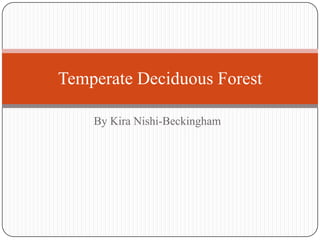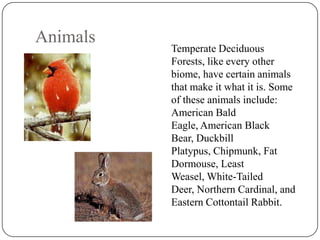Temperate Deciduous Forest
- 1. Temperate Deciduous Forest By Kira Nishi-Beckingham
- 2. World Distribution Temperate Deciduous Forests can be found in the eastern half of the United States, the middle of Europe, as well as parts of Asia and New Zeeland
- 3. Abiotic Characteristics Latitude ’āĀ 23.5 to 60 degrees in both the Northern and Sothern Hemispheres Precipitation ’āĀ 750 to 1,500 mm of rain per year Temperature ’āĀ -30 to 30 degrees Celsius (cold winters and hot summers)
- 4. Plants In a Temperate Deciduous Forest, there can be up to 5 zones. The first zone is the Tree Stratum Zone. This zone contains large deciduous trees such as Beach, Oak, Maple, and Hickory.
- 5. Plants Cont. The second zone is called the small tree and sapling zone. This zone contains shorter and younger trees. The third zone is called the shrub zone, containing shrubs such as mountain laurel and huckleberries.
- 6. Plants Cont. The fourth zone is called the herb zone, which contains short plants such as herbal plants, wildflowers, and berries. The final zone is called the ground zone which contains mosses and lichen.
- 7. Animals Temperate Deciduous Forests, like every other biome, have certain animals that make it what it is. Some of these animals include: American Bald Eagle, American Black Bear, Duckbill Platypus, Chipmunk, Fat Dormouse, Least Weasel, White-Tailed Deer, Northern Cardinal, and Eastern Cottontail Rabbit.
- 8. Climate Precipitation ’āĀ 750 to 1,500 mm of rain per year Temperature ’āĀ -30 to 30 degrees Celsius (cold winters and hot summers)
- 9. Bioaccumulation Things like pollution cause extreme damage to biomes such as Temperate Deciduous Forests. It causes acid rain which in turn can destroy the leaves, stunt the growth of fruit and even kill the trees. Pollution also causes Global Warming which causes less precipitation which means the forest wonŌĆÖt receive the amount of water that is necessary for optimal growth. This also affects the herbivores because it means there is less plants for them to eat.
- 10. Bioaccumulation Humans are extremely detrimental to the forests as we strip the trees away for our benefit. We clear huge areas of land for use in agriculture, clear cut logging, and mining. Mining is especially bad as the forests cannot re-grow on the damaged soil.
- 11. Intrusive Species An intrusive species is a plant or animal that is non-native to the biome and has a negative affect. Some examples for a Temperate Deciduous Forest are: ŌĆóWineberry ’āĀ this plant grows quickly into dense thickets and takes over so that the trees no longer have any room to grow. ŌĆóJapanese Knotweed ’āĀ this plant spreads fast and dominates the land its on. Almost no other species of plant is able to grow where this one is. ŌĆóGarlic Mustard ’āĀ this plant is not only fast growing and takes over the land, but it also releases poisonous chemicals that harm the soil, fungi, and in turn the trees.
- 12. Energy Flows Second Trophic Level: The Primary Consumers use about 6,000 Kilocalories per square meter per year, however only 10% of this is stored in their bodies as the other 90% is used for cellular activities
- 13. Energy Flows Third Trophic Level: The Secondary Consumers are able to utilize 600 Kilocalories per square meter per year, however only 10% of this is stored in their bodies as the other 90% is used for cellular activities
- 14. Energy Flows Fourth Trophic Level: The Tertiary Consumers are only able to get 60 Kilocalories per square meter per year so they have to hunt a larger area in order to survive
- 15. Biotic Relationships Mutualism: An example of mutualism is the relationship between a deer and a bird. The bird gets food while eating insects off the deer and the deer gets rid of this insects on it. Parasitism: An example of parasitism is the relationship between a tapeworm and an animal. The tapeworm takes away nutrients from the animal in order to survive.
- 16. Biotic Relationships Commensalism: An example of commensalism is the relationship between a squirrel and a tree. The squirrel gets shelter and protection from predators and the tree is not harmed or benefitted.
- 17. Succession Succession is the order of plant growth. This is the succession of plant growth in a Temperate Deciduous Forest.
- 18. Predator-Prey Interactions An example of a predator-prey interaction is the relationship between a spider and insects. Insects, the prey, get eaten by the spider, the predator, to give the spider the nutrients it needs to survive.
- 19. Bibliography "Beech Tree Pictures." Beech Tree: Pictures, Photos, Images, Facts on Beech Trees. N.p., n.d. Web. 15 Feb. 2014. "Climate:." Temperate Deciduous Forest. N.p., n.d. Web. 13 Feb. 2014. "Climate:." Temperate Deciduous Forest. N.p., n.d. Web. 16 Feb. 2014. "Deciduous Forest Food Pyramid." Tutorvista.com. N.p., n.d. Web. 17 Feb. 2014. "Examples of Mutalism, Commensalism, Parasitism, and Predator and Prey - Www.temperatedecidiousforest.com." Www.temperatedecidiousforest.com. N.p., n.d. Web. 17 Feb. 2014. "Falling Trees Help Invasive Wineberry Move into Deciduous Forests in North America." Smithsonian Science. N.p., n.d. Web. 17 Feb. 2014.
- 20. Bibliography "Statue Tree Information from Statues to Trees. Then Plant, Relax and Enjoy!" Statue Tree. N.p., n.d. Web. 15 Feb. 2014. "Temperate Decidious Group A." Cougarbiology /. N.p., n.d. Web. 15 Feb. 2014. "Temperate Deciduous Forest - Biomes of the World." Biomes of the World. N.p., n.d. Web. 17 Feb. 2014. "Temperate Deciduous Forest : Mission: Biomes." Temperate Deciduous Forest : Mission: Biomes. N.p., n.d. Web. 16 Feb. 2014. "Temperate Deciduous Forest Animal Printouts EnchantedLearning.com." Temperate Deciduous Forest Animal Printouts - EnchantedLearning.com. N.p., n.d. Web. 14 Feb. 2014. "Temperate Deciduous Forests." Prezi.com. N.p., n.d. Web. 17 Feb. 2014.
- 21. Bibliography "Habitat Awareness Temperate Deciduous Forest." Habitat Awareness Temperate Deciduous Forest. N.p., n.d. Web. 15 Feb. 2014. "Migration Research Foundation - Labrador 2006 - Flora." Migration Research Foundation - Labrador 2006 - Flora. N.p., n.d. Web. 15 Feb. 2014. "Moss Art." Moss Art. N.p., n.d. Web. 15 Feb. 2014. "Page Not Found ŌĆō Live Your Dream." Walking On Water RSS. N.p., n.d. Web. 15 Feb. 2014. "Reforestation.me." Reforestationme. N.p., n.d. Web. 17 Feb. 2014. "Signs of Spring 14: Rise of the Exotic Invasives!" Ecologist's Notebook. N.p., n.d. Web. 17 Feb. 2014.
- 22. THE END





















